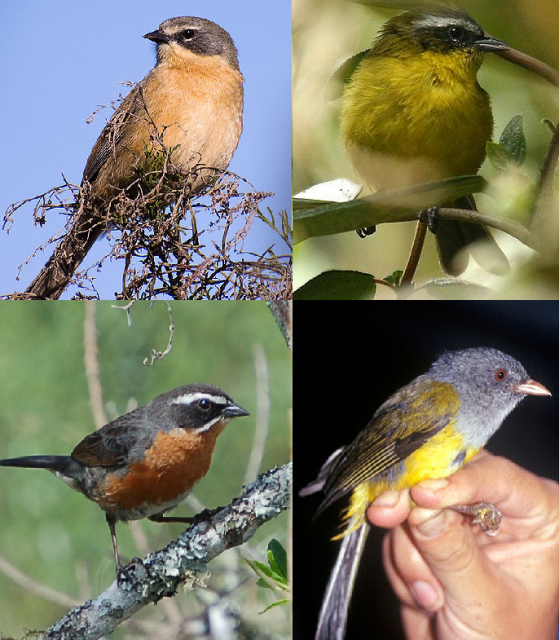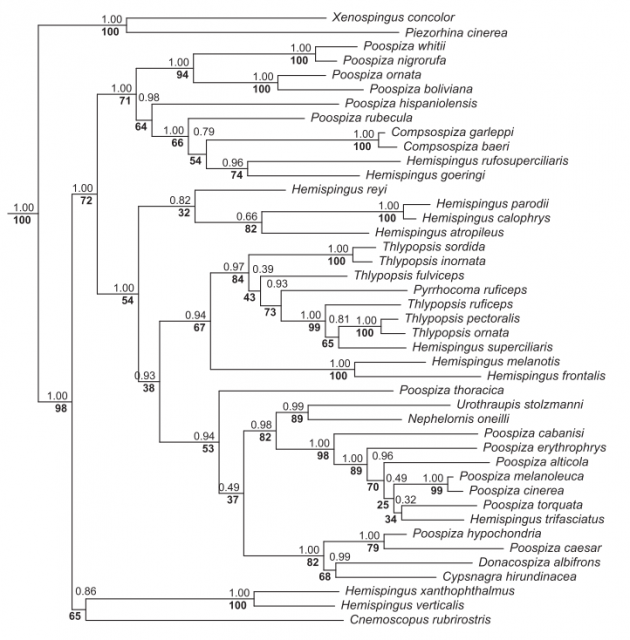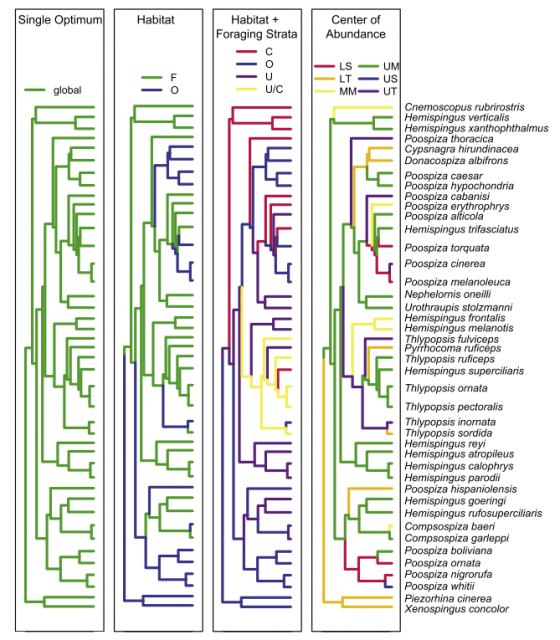Plumage evolution: testing hypotheses in tanagers
Life is full of compromises, and so is evolution. We often wonder about the explanation for particular traits that we find in many different organisms; distinct characteristics present in some of those organisms but not in others. We may hypothesize their story, and it can make sense, but finding actual evidence to support it will not be easy. Different pressures influence the potential effect of the natural selection, pressures that can even be antagonistic. Take, for instance, the plumage of a bird. One may think that a significant selective pressure would favor a color and brightness of the feathers that matches with the environment, making it harder to predators to find the individual with that cryptic pattern. On the other hand, we know that many birds bear conspicuous plumages that are involved in territorialism or sexual selection. These tradeoffs are well known in evolutionary ecology, but can we really assess that a particular explanation of trait evolution is more reliable than others?
A recent study 1 undertaken on many South-American tanagers addressed these kind of questions. Tanagers (family Thraupidae) are a very diversified lineage of birds endemic of the New World including more than 200 species. Together with other well-known passerines, such as finches (Fringillidae) or the American blackbirds (Icteridae) comprise the “9-primaried oscine” clade, a successful group that represents 10% of all birds of the World. Tanagers are a particularly interesting field of study for evolutionary ecology. They are well known by a wide range of plumage patterns, including dull-colored forms as well as bright and eye-catching taxa. They are also remarkably complex taxonomically: their morphological plasticity has constituted a challenge to ornithologists for many decades, and more recently, evidences derived from molecular phylogenetics resulted in several major taxonomical changes. The famous Darwin’s finches of Galapagos, for instance, are not included in the family Emberizidae anymore, but in Thraupidae. Conversely, other putative tanagers are now accommodated in different families. Finally, tanagers are present in very different habitats, ranging several altitudinal ranges as well as open to forested landscapes.

Different data sources were included in the study. Firstly, a phylogenetic reconstruction of a selection of 43 species of tanagers included in 12 different genera. To reconstruct their relationships, four regions of the nuclear genome and two of the mitochondrial genome were amplified and sequenced, and subsequently analyzed by Maximum Likelihood and Bayesian Inference. In addition, plumage coloration and brightness of these birds was measured with a reflectance spectrophotometer in nine different regions of each bird. Specimens from different scientific collections belonging to both sexes of the taxa included in the study were examined, providing for each species its “avian tetrahedral color space”, a standardized plot that allows easily plumage comparison. Finally, each bird was also categorized according to its habitat preference: open or closed. Birds living in closed habitats were further classified in the preference for the canopy or understory, as well as for the elevational zone where the species is most abundant.
The ultimate goal was not only to provide a novel phylogenetic reconstruction, but to use the phylogeny as a scaffold to test plumage evolution testing different models: a single optimum ; a selective regime for open and closed habitats; habitats and foraging strata (canopy or understory); or centre of abundance (elevation). If the validation algorithm shows a preference for the single optimum model, no habitat constrain can be assessed. However, if any of the remaining models is preferred by the algorithm, the selective pressure on the plumage can be related to the correspondent habitat variation. A preference for the open/closed habitat model, or the habitat+strata model would stress the importance, for instance, of cryptic patters of plumage matching the background. Finally, the elevational model predicts that birds at higher altitudes show less complex patterns or behavior due to the lack of resources, as shown in previous studies.

The phylogenetic approach showed a previously unknown relationship among genera long considered tanagers together with other species traditionally considered emberizids. Additionally, several genera turned out to be polyphyletic. This is not surprising in such a complex family, as we said before, but it seems that ornithologists will still be working for a while on tanager taxonomy.
Regarding plumage evolution, the results suggested that the habitat significantly contributed in shaping these birds appearance. Models including the consideration of open and closed habitats or the different forest strata performed better than the one based on elevation. Most of the measured plumage characteristics are best explained under a selection caused by open or closed habitats favoring crypsis. Lineages with a greater diversity of patterns and colors are more frequent in closed habitats, while open environments (which have a smaller variation in background colors) favor less colorful plumages in this clade. Brilliance was the only trait better explained by the more complex model including habitats and foraging strata. Selection due to the habitat elevation, however, did not mean a selective pressure for plumage evolution, maybe because the hypothetical resource gradient is not reflected in a selective pressure for plumage.

The gap between an interesting hypothesis about the major evolutionary events that drive morphological variation and a reconstruction of those events supported by evidence is a challenge that many ecologists have to face in their research. Phylogenetic approaches provide a very useful tool: a historical reconstruction of the lineages and their diversification that can be used to test the homology of the traits that we perceive.
References
- Shultz, A. J. & Burns, K. J. 2013. Plumage evolution in relation to light environment in a novel clade of Neotropical tanagers. Molecular Phylogenetics and Evolution 66, 112–125 ↩